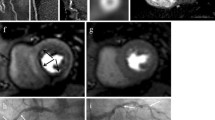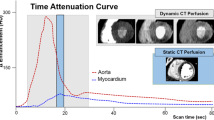Abstract
Myocardial perfusion imaging is commonly used to risk-stratify patients based on the presence and extent of stress-induced myocardial ischemia. Recent studies have shown that both positron and single photon emission tomography techniques can be used to assess the effectiveness of coronary revascularization procedures as well as various anti-ischemic medical therapies on myocardial perfusion. In this regard, perfusion imaging may be used not only to assess initial risk but also to track subsequent risk based on changes in perfusion results following medical and/or interventional therapies.
Similar content being viewed by others
References and Recommended Reading
Mahmarian JJ, Shaw LJ, Filipchuk NG, et al.; for the INSPIRE Investigators: A multinational study to establish the value of early adenosine technetium-99m sestamibi myocardial perfusion imaging in identifying a low-risk group for early hospital discharge after acute myocardial infarction. J Am Coll Cardiol 2006, 48:2448–2457.
Mahmarian JJ, Dakik HA, Filipchuk NG, et al.; for the Adenosine Sestamibi SPECT Post-Infarction Evaluation (INSPIRE) Investigators: An initial strategy of intensive medical therapy is comparable to that of coronary revascularization for suppression of scintigraphic ischemia in high risk but stable survivors of acute myocardial infarction. J Am Coll Cardiol 2006, 48:2458–2467.
Boden WE, O’Rourke RA, Teo KK, et al.; for the COURAGE Trial Research Group: Optimal medical therapy with or without PCI for stable coronary disease. N Engl J Med 2007, 356:1503–1516.
Shaw LJ, Berman DS, Maron DJ, et al.; COURAGE Investigators: Optimal medical therapy with or without percutaneous coronary intervention to reduce ischemic burden. Results from the Clinical Outcomes Utilizing Revascularization and Aggressive Drug Evaluation (COURAGE) trial nuclear substudy. Circulation 2008, 117:1283–1291.
Schelbert HR, Phelps ME, Huang SC, et al.: N-13 ammonia as an indicator of myocardial blood flow. Circulation 1981, 63:1259–1272.
Kuhle WG, Porenta G, Huang SC, et al.: Quantification of regional myocardial blood flow using 13N-ammonia and reoriented dynamic positron emission tomographic imaging. Circulation 1992, 86:1004–1017.
Bergmann SR, Herrero P, Markham J, et al.: Noninvasive quantitation of myocardial blood flow in human subjects with oxygen-15-labeled water and positron emission tomography. J Am Coll Cardiol 1989, 14:639–652.
Gould KL, Martucci JP, Goldberg DI, et al.: Short-term cholesterol lowering decreases size and severity of perfusion abnormalities by positron emission tomography after dipyridamole in patients with coronary artery disease. A potential noninvasive marker of healing coronary endothelium. Circulation 1994, 89:1530–1538.
Czernin J, Barnard RJ, Sun KT, et al.: Effect of short-term cardiovascular conditioning and low-fat diet on myocardial blood flow and flow reserve. Circulation 1995, 92:197–204.
Huggins GS, Pasternak RC, Alpert NM, et al.: Effects of short-term treatment of hyperlipidemia on coronary vasodilator function and myocardial perfusion in regions having substantial impairment of baseline dilator reverse. Circulation 1998, 98:1291–1296.
Baller D, Notohamiprodjo G, Gleichmann U, et al.: Improvement in coronary flow reserve determined by positron emission tomography after 6 months of cholesterol-lowering therapy in patients with early stages of coronary atherosclerosis. Circulation 1999, 99:2871–2875.
Guethlin M, Kasel AM, Coppenrath K, et al.: Delayed response of myocardial flow reserve to lipid-lowering therapy with fluvastatin. Circulation 1999, 99:475–481.
Janatuinen T, Laaksonen R, Vesalainen R, et al.: Effect of lipid-lowering therapy with pravastatin on myocardial blood flow in young mildly hypercholesterolemic adults. J Cardiovasc Pharmacol 2001, 38:561–568.
Yokoyama I, Yonekura K, Inoue Y, et al.: Long-term effect of simvastatin on the improvement of impaired myocardial flow reserve in patients with familial hypercholesterolemia without gender variance. J Nucl Cardiol 2001, 8:445–451.
Sdringola S, Nakagawa K, Nakagawa Y, et al.: Combined intense lifestyle and pharmacologic lipid treatment further reduce coronary events and myocardial perfusion abnormalities compared with usual-care cholesterol-lowering drugs in coronary artery disease. J Am Coll Cardiol 2003, 41:263–272.
Bottcher M, Czernin J, Sun K, et al.: Effect of beta 1 adrenergic receptor blockade on myocardial blood flow and vasodilatory capacity. J Nucl Med 1997, 38:442–446.
Beanlands RS, Nahmias C, Gordon E, et al.: The effects of beta(1)-blockade on oxidative metabolism and the metabolic cost of ventricular work in patients with left ventricular dysfunction: a double-blind, placebo-controlled, positron-emission tomography study. Circulation 2000, 102:2070–2075.
Bottcher M, Refsgaard J, Gotzsche O, et al.: Effect of carvedilol on microcirculatory and glucose metabolic regulation in patients with congestive heart failure secondary to ischemic cardiomyopathy. Am J Cardiol 2002, 89:1388–1393.
Bennett SK, Smith MF, Gottlieb SS, et al.: Effect of metoprolol on absolute myocardial blood flow in patients with heart failure secondary to ischemic or nonischemic cardiomyopathy. Am J Cardiol 2002, 89:1431–1434.
Bottcher M, Refsgaard J, Madsen MM, et al.: Effect of antianginal medication on resting myocardial perfusion and pharmacologically induced hyperemia. J Nucl Cardiol 2003, 10:345–352.
Koepfli P, Wyss CA, Namdar M, et al.: Beta-adrenergic blockade and myocardial perfusion in coronary artery disease: differential effects in stenotic versus remote myocardial segments. J Nucl Med 2004, 45:1626–1631.
Fallen EL, Nahmias C, Scheffel A, et al.: Redistribution of myocardial blood flow with topical nitroglycerin in patients with coronary artery disease. Circulation 1995, 91:1381–1388.
Bottcher M, Madsen MM, Randsbaek F, et al.: Effect of oral nitroglycerin and cold stress on myocardial perfusion in areas subtended by stenosed and nonstenosed coronary arteries. Am J Cardiol 2002, 89:1019–1024.
Pitkanen OP, Raitakari OT, Niinikoski H, et al.: Coronary flow reserve is impaired in young men with familial hypercholesterolemia. J Am Coll Cardiol 1996, 28:1705–1711.
Dayanikli F, Grambow D, Muzik O, et al.: Early detection of abnormal coronary flow reserve in asymptomatic men at high risk for coronary artery disease using positron emission tomography. Circulation 1994, 90:808–817.
Shehata AR, Gillam LD, Mascitelli VA, et al.: Impact of acute propranolol administration on dobutamine-induced myocardial ischemia as evaluated by myocardial perfusion imaging and echocardiography. Am J Cardiol 1997, 80:268–272.
Murphy DR, White CM, Katten D, et al.: Effect of intravenous metoprolol or intravenous metoprolol plus glucagon on dobutamine-induced myocardial ischemia. Pharmacotherapy 2000, 20:1303–1309.
Taillefer R, Ahlberg AW, Masood Y, et al.: Acute beta-blockade reduces the extent and severity of myocardial perfusion defects with dipyridamole Tc-99m sestamibi SPECT imaging. J Am Coll Cardiol 2003, 42:1475–1483.
Stegaru B, Loose R, Keller H, et al.: Effects of long-term treatment with 120 mg of sustained-release isosorbide dinitrate and 60 mg of sustained-release nifedipine on myocardial perfusion. Am J Cardiol 1988, 61:74E–77E.
Aoki M, Sakai K, Koyanagi S, et al.: Effect of nitroglycerin on coronary collateral function during exercise evaluated by quantitative analysis of thallium-201 single photon emission computed tomography. Am Heart J 1991, 121:1361–1366.
Mahmarian JJ, Fenimore NL, Marks GF, et al.: Transdermal nitroglycerin patch therapy reduces the extent of exercise-induced myocardial ischemia: results of a double-blind, placebo-controlled trial using quantitative thallium-201 tomography. J Am Coll Cardiol 1994, 24:25–32.
Lewin HC, Hachamovitch R, Harris AG, et al.: Sustained reduction of exercise perfusion defect extent and severity with isosorbide mononitrate (Imdur) as demonstrated by means of technetium 99m sestamibi. J Nucl Cardiol 2000, 7:342–353.
Schuler G, Hambrecht R, Schlierf G, et al.: Myocardial perfusion and regression of coronary artery disease in patients on a regimen of intensive physical exercise and low fat diet. J Am Coll Cardiol 1992, 19:34–42.
Eichstadt HW, Eskotter H, Hoffmann I, et al.: Improvement of myocardial perfusion by short-term fluvastatin therapy in coronary artery disease. Am J Cardiol 1995, 76:122A–125A.
Mahmarian JJ, Moye LA, Nasser GA, et al.: Nicotine patch therapy in smoking cessation reduces the extent of exercise-induced myocardial ischemia. J Am Coll Cardiol 1997, 30:125–130.
Mostaza JM, Gomez MV, Gallardo F, et al.: Cholesterol reduction improves myocardial perfusion abnormalities in patients with coronary artery disease and average cholesterol levels. J Am Coll Cardiol 2000, 35:76–82.
Hosokawa R, Nohara R, Linxue L, et al.: Effect of long-term cholesterol-lowering treatment with HMG-CoA reductase inhibitor (simvastatin) on myocardial perfusion evaluated by thallium-201 single photon emission computed tomography. Jpn Circ J 2000, 64:177–182.
Schwartz RG, Pearson TA, Kalaria VG, et al.: Prospective serial evaluation of myocardial perfusion and lipids during the first six months of pravastatin therapy: coronary artery disease regression single photon emission computed tomography monitoring trial. J Am Coll Cardiol 2003, 42:600–610.
Manfrini O, Pizzi C, Morgagni GL, et al.: Effect of pravastatin on myocardial perfusion after percutaneous transluminal coronary angioplasty. Am J Cardiol 2004, 93:1391–1393.
Parisi AF, Hartigan PM, Folland ED, for the ACME Investigators: Evaluation of exercise thallium scintigraphy versus exercise electrocardiography in predicting survival outcomes and morbid cardiac events in patients with single- and double-vessel disease. Findings from the Angioplasty Compared to Medicine (ACME) Study. J Am Coll Cardiol 1997, 30:1256–1263.
Sharir T, Rabinowitz B, Livschitz S, et al.: Underestimation of extent and severity of coronary artery disease by dipyridamole stress thallium-201 single-photon emission computed tomographic myocardial perfusion imaging in patients taking antianginal drugs. J Am Coll Cardiol 1998, 31:1540–1546.
Dakik HA, Kleiman NS, Farmer JA, et al.: Intensive medical therapy versus coronary angioplasty for suppressing myocardial ischemia in survivors of acute myocardial infarction: a prospective randomized pilot study. Circulation 1998, 98:2017–2023.
Hendel RC, Henry TD, Rocha-Singh K, et al.: Effect of intracoronary recombinant human vascular endothelial growth factor on myocardial perfusion: evidence for a dose-dependent effect. Circulation 2000, 101:118–121.
Udelson JE, Dilsizian V, Laham RJ, et al.: Therapeutic angiogenesis with recombinant fibroblast growth factor-2 improves stress and rest myocardial perfusion abnormalities in patients with severe symptomatic chronic coronary artery disease. Circulation 2000, 102:1605–1610.
Henry TD, Rocha-Singh K, Isner JM, et al.: Intracoronary administration of recombinant human vascular endothelial growth factor to patients with coronary artery disease. Am Heart J 2001, 142:872–880.
Grines CL, Watkins MW, Mahmarian JJ, et al.: Angiogene Gene Therapy (AGENT-2) Study Group: A randomized, double-blind, placebo-controlled trial of Ad5FGF-4 gene therapy and its effect on myocardial perfusion in patients with stable angina. J Am Coll Cardiol 2003, 42:1339–1347.
Abrams J: Hemodynamic effects of nitroglycerin and long-acting nitrates. Am Heart J 1985, 110:216–224.
Kelly RP, Gibbs HH, O’Rourke MF, et al.: Nitroglycerin has more favourable effects on left ventricular afterload than apparent from measurement of pressure in a peripheral artery. Eur Heart J 1990, 11:138–144.
Brown BG, Bolson E, Petersen RB, et al.: The mechanisms of nitroglycerin action: stenosis vasodilatation as a major component of the drug response. Circulation 1981, 64:1089–1097.
McFadden EP, Clarke JG, Davies GJ, et al.: Effect of intracoronary serotonin on coronary vessels in patients with stable angina and patients with variant angina. N Engl J Med 1991, 324:648–654.
Allred EN, Bleecker ER, Chaitman BR, et al.: Short-term effects of carbon monoxide exposure on the exercise performance of subjects with coronary artery disease. N Engl J Med 1989, 321:1426–1432.
Author information
Authors and Affiliations
Corresponding author
Rights and permissions
About this article
Cite this article
Mahmarian, J.J. Myocardial perfusion imaging to evaluate the efficacy of medical therapy in patients with coronary artery disease. curr cardiovasc imaging rep 2, 183–196 (2009). https://doi.org/10.1007/s12410-009-0023-8
Published:
Issue Date:
DOI: https://doi.org/10.1007/s12410-009-0023-8




